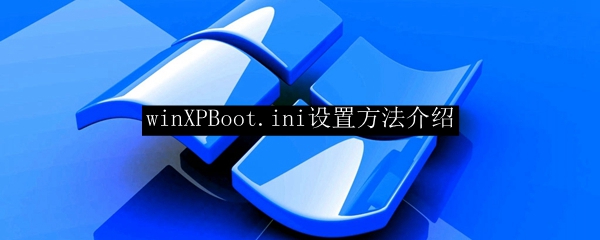 Computer Tutorials
Computer Tutorials
 System Installation
System Installation
 Introduce how to configure the boot setting file Boot.ini of winXP
Introduce how to configure the boot setting file Boot.ini of winXP
Introduce how to configure the boot setting file Boot.ini of winXP
WinxpBoot.ini setting method is that the Boot.ini file is located in the root directory of the C drive. It is a hidden file. Enter "c:\boot.ini" in "Run" to start the file. Click the "Advanced" option in the System Properties dialog box, and then select the "Settings" button in the "Startup and Recovery" item below to pop up a "Startup and Recovery" dialog box.
winXPBoot.ini setting method introduction

1. When we install multiple systems (such as Windows 98 and Windows XP), a system boot menu will appear every time you start the computer. Select the system you want to enter and press Enter. This boot program is called Boot.ini. The program is automatically installed when installing Windows 2000 (XP). Using it, we can easily boot multiple systems in the computer. We can also set a personalized startup menu through this boot file. The Boot.ini file is located in the root directory of drive C and is a hidden file. Enter "c:\boot.ini" in "Run" to start the file.
2. The delay time is when the system starts the boot menu and the user does not perform any operations within the set delay time, it will enter the default operating system. The system default delay time is 30 seconds. If you feel that the default delay time is too long, you can enter the delay time you need, such as 10 seconds. When setting, first open the Boot.ini file (be careful to remove the hidden and read-only attributes of the file), then find the "timeout =" statement under the [boot loader] field, and change 30 in it to 10. We can also modify it in the System Configuration Utility. Type the "Msconfig" command in "Start/Run", click the "Boot.ini" label in the pop-up "System Configuration Utility" (Figure 2), click "Timeout XX seconds" in the "Boot.ini" interface "Enter the required delay time in the item.
3. During multi-system startup, there is an operating system selection list. These lists display the names of all operating systems in the computer, such as: Microsoft Windows XP Professional. We can modify these display contents and load some personalized settings. Open the "boot.ini" file and find the [operating systems] field. This field displays the current operating system list. Its format is multi(0)disk(0)rdisk(0)partition(3)\WINDOWS="Microsoft Windows XP Professional”/fastdetect. The part in quotation marks after it is the content displayed when the system starts. Just change the content in quotation marks to the text you need.
4. After multiple systems are installed, Boot.ini will set one of the systems as the default startup system, such as Windows XP. After the delay time expires, the default system will be automatically booted. We can change the default startup system to other systems (such as Windows 98) as needed. When making changes, first right-click "My Computer", select "Properties", click the "Advanced" option in the system properties dialog box, and then select the "Settings" button in the "Startup and Recovery" item below to pop up a Startup and Recovery dialog box. Click the default operating system drop-down menu in the "System Startup" item, select a required system, and click "OK".
5. Boot.ini provides a lot of parameter commands when booting multiple systems. These startup parameters can produce different startup effects. Boot.ini loads the /fastdetect parameter by default, which means that the serial port and parallel port are not checked at startup. In fact, we can change it to other parameters. When changing, first select the system list that needs to be changed in "Boot.ini", and then change the parameter /fastdetect in the system to the corresponding parameter value. When you start the system in the future, some setting information or screens will be loaded. We can set some parameters in the "System Configuration Utility", switch to the "Boot.ini" option, first select the system that needs to be changed, and then check the required startup parameters at the bottom of the "Startup Options". Several commonly used parameters are explained here.
6. /SAFEBOOT: Safe boot, only starts the drivers and services in HKLM\System\CurrentControlSetControl\SafeBoot, followed by three parameters: Minimal, Network or Dsrepair. Minimal and Network allow the system to be started with a network connection. Dsrepair requires the system to load the Active Directory settings from the backup device. Another option is Minimal (AlternateShell), which allows the system to call the SHELL program specified by HKLM\System\CurrentControlSetSafeBoot\AlternateShell instead of using the default Explorer.
7. /NOGUIBOOT: If the VGA driver is not loaded, the blue screen information during the startup process and failure will not be displayed.
/BOOTLOG: Write the log to the Nnbtlog.txt file.
/BASEVIDEO: Start using the standard VGA method. This method is mainly used when the display driver fails.
/SOS: Display the name of the driver when calling it. It is better to use it when it cannot be started due to driver problems.
The above is the detailed content of Introduce how to configure the boot setting file Boot.ini of winXP. For more information, please follow other related articles on the PHP Chinese website!

Hot AI Tools

Undresser.AI Undress
AI-powered app for creating realistic nude photos

AI Clothes Remover
Online AI tool for removing clothes from photos.

Undress AI Tool
Undress images for free

Clothoff.io
AI clothes remover

AI Hentai Generator
Generate AI Hentai for free.

Hot Article

Hot Tools

Notepad++7.3.1
Easy-to-use and free code editor

SublimeText3 Chinese version
Chinese version, very easy to use

Zend Studio 13.0.1
Powerful PHP integrated development environment

Dreamweaver CS6
Visual web development tools

SublimeText3 Mac version
God-level code editing software (SublimeText3)




